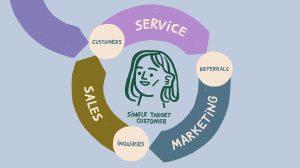Written by Daniela Furtado
Turn your work into content that garners traffic and impresses potential clients. This is how we help interior designers get traffic to their portfolios.
Without any SEO or content marketing practices, your interior design projects online on their own cannot generate the level of attention or traffic that you are looking for.
Every day, your target audience is being bombarded by endless volumes of data online through advertisements, social media, and emails.
So how can you push through all that clutter, find your way to their screens and direct traffic to your design projects? How can you turn your work and expertise into a content marketing engine?
Below, we have put together 3 easy to understand steps that you can follow to get more traffic to your portfolio from search engines like Google, Bing and Pinterest. Whether you’re an architect, interior or landscape designer, contractor, graphic or website designer – these tips can work for you.
How to Get Traffic to Your Portfolio
Rename Your Portfolio Pieces to Be “Searchable”
The first step to get and retain traffic to your portfolio is making your portfolio pieces searchable and discoverable by search engines, like Google, with the help of keywords.
So, what exactly are keywords?
Keywords are words, phrases or questions your target audience types into a search engine, like Google, Yahoo or Bing, to help them find solutions to their problems.
Researching and using these keywords in your content improves your odds of being noticed on the search engines results page by your target audience.
(Want some tips on how to use keywords like a human, not a robot? Read our tips.)
Let’s look at an example:
Let’s say you have designed a restaurant and the design is part of your portfolio. To make this design findable on search engines, avoid being too specific and calling the page “Design for Smith’s Restaurant, Quartier Latin”.
Only people that are familiar with the restaurant and neighbourhood will use those terms and names and find your page.
Instead, give it a name that is searchable by a wider audience. For example, you can call the page “Minimalist Restaurant Design in Downtown Montréal”.
Do you see the difference? In this case, your keyword or keyphrase will be “minimalist restaurant design”.
Now to get this keyword to direct more traffic to your portfolio, add it in the right places throughout your content, such as:
- Use it in the title (H1)
- Use it in the URL
- Use it in the first intro paragraph
- Use it in the subtitles (H2 and H3) where appropriate
- Overall, use it around 10 times throughout the article where appropriate
- Use it in the meta description
- Use it in the image file name and alt tag where appropriate
When you work with a professional SEO consultant (like us!), they can help by researching the list of keywords your target customers are using on Google and decide which keywords you should use in your content and how.
Now that you understand SEO keywords, let’s look at the next step.
Use Your Portfolio to Tell a Story
The most common mistake I see architects, designers and contractors make is they upload just a simple photo gallery to their portfolio. However, Google can’t read images as well as it can read text (for now, it’s working on the technology!).
If you want to get more traffic to your portfolio, present us with context for each portfolio piece. Use your portfolio to tell us a story; what did the space look like before? What was the vision? Elaborate and show us both the process and progression of your work. That is, what happened at each phase?
You can include your sketches, renderings and photos to add visuals to your content. Don’t just show us the “after”; show us the “before” and “during”. Make us walk the journey through your eyes.
Adding more content will give you more opportunities to use keywords. A good use of keywords will help you rank on the first results page of Google and get traffic to your design pieces.
Here’s an example of how we turned a modern dental design project into a case study for our client PROP architecture.
We also suggest you include testimonials from your clients. Your portfolio can act both as a content marketing or brand asset tool and a sales tool.
Pro Tip: Our professional advice is to create a content structure or template that you could use for all your portfolio pieces. This way the flow is consistent and easy to understand.
Now let’s take a look at our third and final step.
Turn Your Portfolio into Blog Posts
Before someone decides to hire an architect, designer or contractor, they often search for ideas, inspiration or tutorials online. The range of keywords used around these subjects, get a lot more traffic. You can capture some of this traffic by creating blog posts that include those keywords. This is a great way to turn your interior design portfolio into content.
For instance, our client SevenPoints Interior is a retail design firm. They have been working on multiple projects that involve visual merchandising. Here are examples of some of the blog topics they covered, with the help of SEO keywords, on their website to get more traffic to their portfolio:
8 Things to Consider When Choosing Display Cases
They leveraged their expertise to create this blog post, and the examples and photos that were included in the blog post are all their own work. If a reader is interested, they can check out the portfolio or contact the firm for a quote.
This blog post is ranking on Google when users search these keywords:
- “cannabis display cases”
- “how to choose dispensary display cases”
When someone searches any of those keywords, you’re not only giving people what they are looking for (that is, design ideas) but you are also showcasing your work at the same time. If someone likes your work, you’ll be the first to come to mind when they’re thinking about hiring a professional.
What’s Next?
You could have the most creative and unique designs online but that alone is not going to get traffic to your portfolio.
Adding content and using keywords to your portfolio can help you:
- Showcase your expertise
- Impress your website visitors and turn them into fans
- Expand your reach and visibility online
- Attract potential customers and press
Now that you understand what it takes to get traffic to your portfolio, let’s look at your next steps:
- Research keywords. Start by looking at the current volume of traffic generated by your portfolio and the marketing efforts taken to achieve this volume of traffic.
- Put our tips into action. Incorporate the steps provided in this blog to transform your portfolio and your content marketing efforts.
- Distribute your content. Once you revamped your portfolio pieces and blog posts, turn them into social media posts or leverage them to pitch to journalists, podcasters and publications.
- Track and measure your progress. For the next 3 to 6 months, monitor and record the new volume of traffic generated by your portfolio and compare this new data to your old data. What did you find?
The new findings will shine a light on the changes that are working for you and where you need to make adjustments to help you get where you want to be in terms of the volume of traffic.
Daniela Furtado
Daniela Furtado is a consultant, writer and speaker on how to make businesses easy to find online. She is the founder and CEO of Findable Digital Marketing. Off the clock, she enjoys cooking, dancing, and drawing. She is based in Toronto, Canada.
 Never Have Time to Market Yourself? Here’s Why
Never Have Time to Market Yourself? Here’s Why Why You’re Not Getting High-End Clients
Why You’re Not Getting High-End Clients 15 Tips on Digital Marketing for Designers and Architects
15 Tips on Digital Marketing for Designers and Architects

